Holiday Budget System Buyers' Guide
by Zach Throckmorton on November 8, 2011 12:00 AM ESTMotherboards and Features
As mentioned earlier, Cougar Point chipset-based motherboards are fully diversified into every cost niche of the motherboard market. While cutting-edge, flagship motherboards garner the most attention from enthusiasts, inexpensive, no-frills boards are generally just assumed to all be more or less equivalent in performance. But does performance vary between these budget boards? We briefly benchmark a few important motherboard features: LAN, SATA, and USB 2.0 throughput. But before we get to the benchmarks, let's compare features.
I tested eight different budget motherboards—four socket AM3 with AMD chipsets, one FM1 with the A55 chipset, and three based on Intel chipsets (all LGA 1155). Here's a quick rundown of the various features for each board.
| Product |
Platform/ Chipset |
Price |
RAM slots |
Rear USB ports |
LAN |
Graphics ports |
SATA ports |
Expansion slots |
| ASRock A55M-HVS |
FM1 / A55 |
$59 | 2 | 6 USB 2.0 | 1Gb | VGA, HDMI | 6 |
1xPCIe x16 1xPCIe x1 1xPCI |
| ASRock 880GM-LE |
AM3 / 880G + SB710 |
$55 | 2 | 6 USB 2.0 | 1Gb | VGA, DVI | 6 |
1xPCIe x16 1xPCIe x1 2xPCI |
| Biostar A780L3L |
AM3 / 760G + SB710 |
$50 | 2 | 4 USB 2.0 | 100Mb | VGA, DVI | 4 |
1xPCIe x16 2xPCI |
| Biostar A870U3 |
AM3 / 870 + SB850 |
$70 | 4 |
2 USB 2.0, 2 USB 3.0 |
1Gb | VGA, DVI | 6 (6Gb) |
1xPCIe x16 1xPCIe x4 2xPCIe x1 2xPCI |
| MSI 760GM-P33 |
AM3 / 760G + SB710 |
$55 | 2 | 4 USB 2.0 | 1Gb | VGA | 6 |
1xPCIe x16 2xPCIe x1 1xPCI |
| ASRock H61M-VS |
LGA1156 / H61 |
$54 | 2 | 6 USB 2.0 | 100Mb | VGA | 4 |
1xPCIe x16 1xPCIe x1 |
| Biostar H61ML |
LGA1156 / H61 |
$60 | 2 | 4 USB 2.0 | 100Mb | VGA, DVI | 4 |
1xPCIe x16 1xPCIe x1 2xPCI |
| MSI H61M-P21 |
LGA1156 / H61 |
$55 | 2 | 4 USB 2.0 | 100Mb | VGA | 4 |
1xPCIe x16 3xPCIe x1 |
One thing to note is that of the above motherboards, Biostar and MSI offer 3-year warranties while ASRock offers a 1-year warranty. As you can see, in general, you'll get more for your money from an AMD-based motherboard than an Intel-based motherboard. That is, none of the Intel boards offer Gigabit ethernet, and only one offers DVI in addition to VGA connectivity; the FM1 board is also the only board with an HDMI port. Do the Intel platforms instead offer better performance? Let's find out.
Benchmarks
While we did not perform thorough testing like when we review a specific motherboard, we tested three important metrics for all eight boards: USB 2.0 performance, SATA throughput, and LAN performance.
USB 2.0 performance
We used a Mushkin Ventura Pro USB 3.0 flash drive and CrystalDiskMark 3 to test the sequential write and read speeds of a 1000MB file. While the Intel boards tend to perform better than the AMD boards, the differences here are very minor and would likely not be noticeable in real world scenarios. The single USB 3.0 equipped board would of course be able to run quite a bit faster with an appropriate USB 3.0 flash drive.
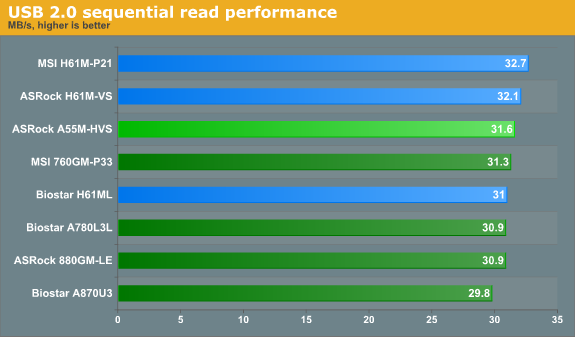
SATA performance
To test SATA performance, we again used CrystalDiskMark 3 to measure the sequential write and read speeds of a 1000MB file—with a Patriot Pyro 120GB SSD. This SSD is one of today's top performers and costs nearly $200—well above the budget sector. However, prices on SSDs will only fall as time passes, and this SSD illustrates what these boards are capable of better than a mechanical HDD. From these results, it's clear that all of the boards perform very similarly in terms of SATA throughput.
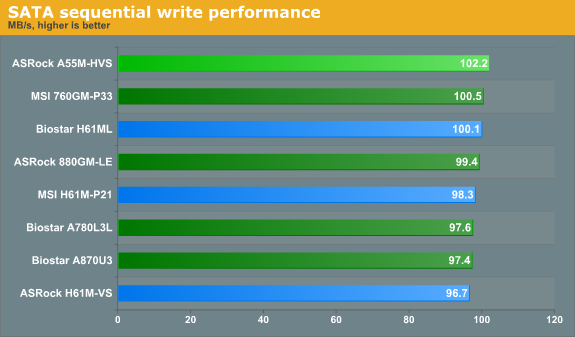

LAN performance
LAN Speed Test is a freeware program designed for testing the network connection between two PCs on a home network. The speed of the transfer is limited by the lowest common denominator on the network, so if you have gigabit ethernet capable computers but a 100 Mbit capable router, you are limited to 100 Mbit transfer. For this test, we use LAN Speed Test to transfer a 1000 MB file across a home network with a 100 Mbps lowest common speed to the same machine each time, in a write/read scenario. It is critically important to note that if you plan on attaching any of the Intel Cougar Point chipset-based boards in this guide to a network, you will be limited to 100 Mbps transfers as none of them have Gigabit adapters.
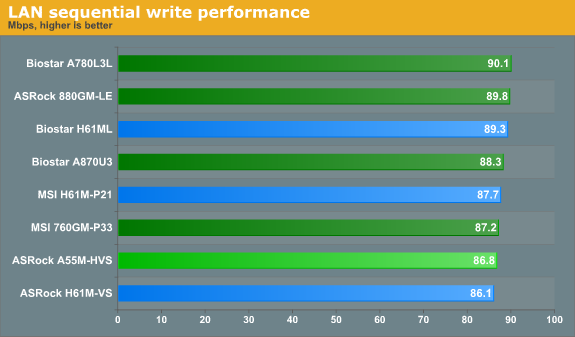
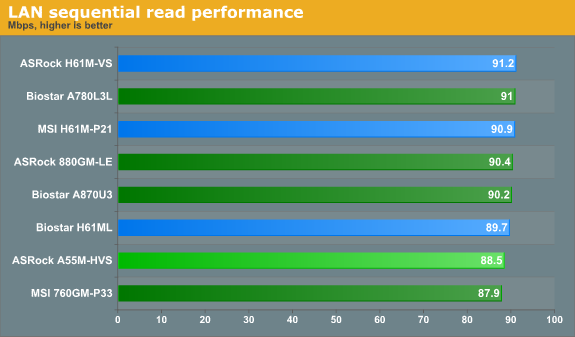
From these benchmarks, it appears that the budget boards are mostly equivalent performers. I was heartened to experience neither anomalous behaviors nor frustrating issues with any of the boards in the course of testing. Though it's somewhat disappointing to not find a hidden gem, it is useful to know that many budget boards are solid performers—so savvy consumers can watch for sales and rebates.
We cover the rest of the system components on the next page.


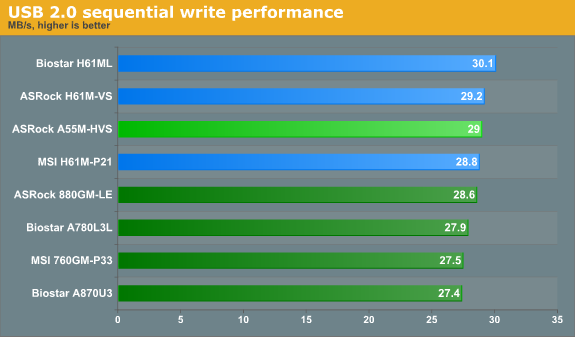








95 Comments
View All Comments
Taft12 - Tuesday, November 8, 2011 - link
Not only do you not need a graphics card, you'll have much better thermals and acoustics from your small form factor HTPC case without an additional furnace in the case.Death666Angel - Tuesday, November 8, 2011 - link
This was precisely why I chose an A6-3500 for my HTPC. I came from a Core i3 530 (which could OC to about 4GHz) and an HD4670. I used it for a few games (beat em ups, racing games etc.) and of course movies/tv series of all sorts. But once I decided to get a new, smaller case (I had a desktop HTPC case that fit 7HDDs but they moved to a dedicated file server making the case too big for the living room), I decided against the SNB line up, because of the crappy game performance. My Llano setup saved me money assuming I went for a SNB setup with equal graphics power. And then, the system would not have allowed the case I ended up using (half height, no PCI slot in the back, 60W PSU). I is awesome to just have to worry about cooling one thing, not an extra graphics card and no IGP chip on the motherboard. :-)Overall, I think this article is interesting but a bit all over the place. As others have mentioned, you compare Llano sans graphics card to X2/Celeron with graphics card.... you don't show the power consumption of those two with graphics card.... While I agree with the overall theme of it, it is not very thorough or thought through. I think people not familiar with all the different tests will have a harder time figuring out which is the best setup for them.
I also don't like the dual-core Llanos. The graphics part is too cut down. The triple core for me was a great balance, because I needed to fit the 60W envelope of the PSU (works great with undervoling, I'm at 54W@2400MHz LinX) and I wanted a powerful graphics part. And the difference between the dual core and triple core parts for me was about 15 or 20€. If I wanted, the triple core also looks to be easily overclockable with K10Stat from within windows.
But enough ranting for now. :D
piroroadkill - Tuesday, November 8, 2011 - link
Sure, the GPU may be a bit worse than the Llano system, but you can't underestimate the usefulness of already having a socket 1155 board. You're immediately open to THE best upgrade path with nothing more than a flip, a click, and a pop of 4 pins.piroroadkill - Tuesday, November 8, 2011 - link
Along those lines, I'd spend a teeny bit more to begin with on the PSU. Then you're all set.Lunyone - Tuesday, November 8, 2011 - link
The PSU is just fine, IMHO. I have a e6700, 6850 GPU, 4 gb's DDR2, 2 DVD's, & 1 HD being powered by the Antec 380w PSU. It runs just fine and no issues whatsoever, so these systems have plenty of upgrade path with the PSU's selected. Now if you get a really power consuming GPU than you should upgrade the PSU, but most people the PSU is just fine.Dustin Sklavos - Tuesday, November 8, 2011 - link
Honestly, people grossly overestimate the amount of PSU they need these days. My desktop is running an 80 Plus Gold 1.2kw PSU, but under heavy load only pulls maybe 510 watts? That's with an overclocked i7-990X, overclocked GTX 580, four hard drives, an SSD, a separate USB 3.0 card, AND a GeForce GT 430 driving two other monitors.So long as the PSU is quality (and mine is) and the amperage is right, people could be getting by with a LOT less these days than they actually use. On the flipside, if I ever completely lose my mind, at least I know my desktop'll take a second 580. ;)
JarredWalton - Tuesday, November 8, 2011 - link
Look who's talking about overestimating power requirements. LOL. 1.2kW PSU, Dustin? I'm running my GTX 580 off a "paltry" 750W model. ;-)ckryan - Tuesday, November 8, 2011 - link
Man, my OCd 2500K P67 system idles at 50w@the wall and pulls about 200w gaming... with a 650w Seasonic X series PSU. That's about the same ballpark of ridiculous, but as soon as someone makes an equally great 350w I'll get one. 1.2KW is pretty silly though... I hope the PSU was comped at least. I got the Seasonic for $100 shipped and the fan never comes on even when gaming so that's one justification.Incidentally, I just purchased the G530 to drop in a H67 board for my SSD endurance testing rig. After playing with it for a while, I think it's well worth the premium the CPU is going for over MSRP. I could see just about every one I know using a G530 and thinking it's the greatest thing ever. The problem with SB Celerons and Pentiums is the motherboards. H61 boards are just not that good, and H67 boards are a little too expensive for a $50 processor. I already had a Biostar TH67+ laying around, and the system is now sitting in my entertainment center trying to put a SSD in the dirt at the rate of over 10.5TB a day. If Intel actually cared about what I want, they'd release a i3 K series as that's the SB I'd really like to see. I considered getting an i3, but I couldn't justify spending $130 for a processor that will spend it's entire life at idle putting SSDs to the sword.
Dustin Sklavos - Tuesday, November 8, 2011 - link
Yeah, the PSU was comped. That's why I'm using it. 1.2kW is most definitely nuts. ;)jabber - Tuesday, November 8, 2011 - link
Yeah we really need a manufacturer to bring out the ultimate baddass 450W PSU that delivers top quality and most of us can use that instead of these frankly ridiculous mega supplies we feel we need to buy.